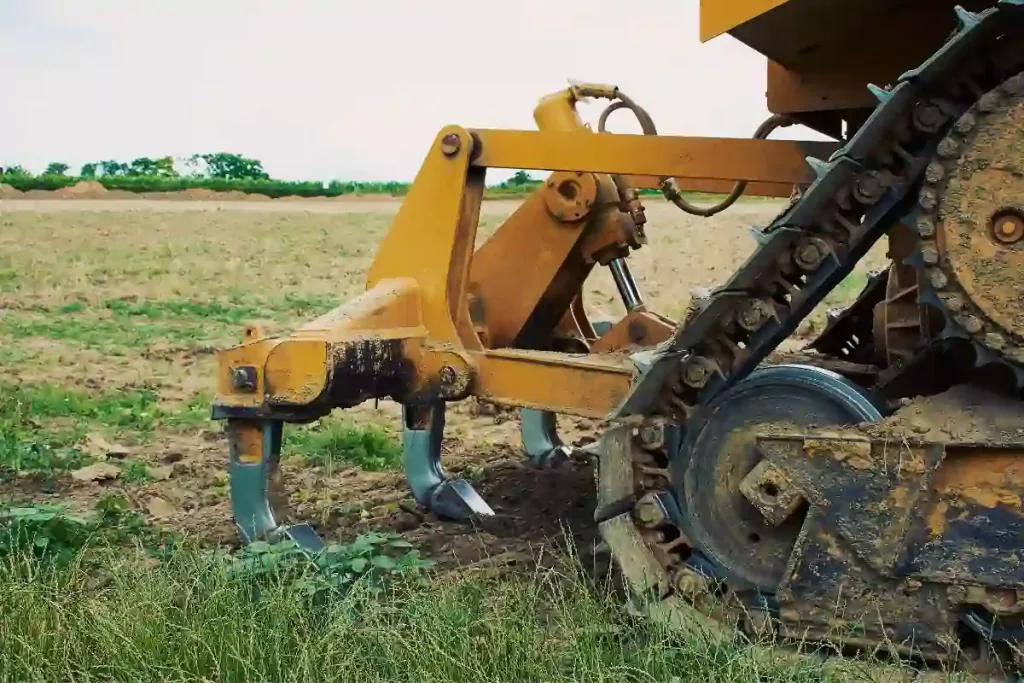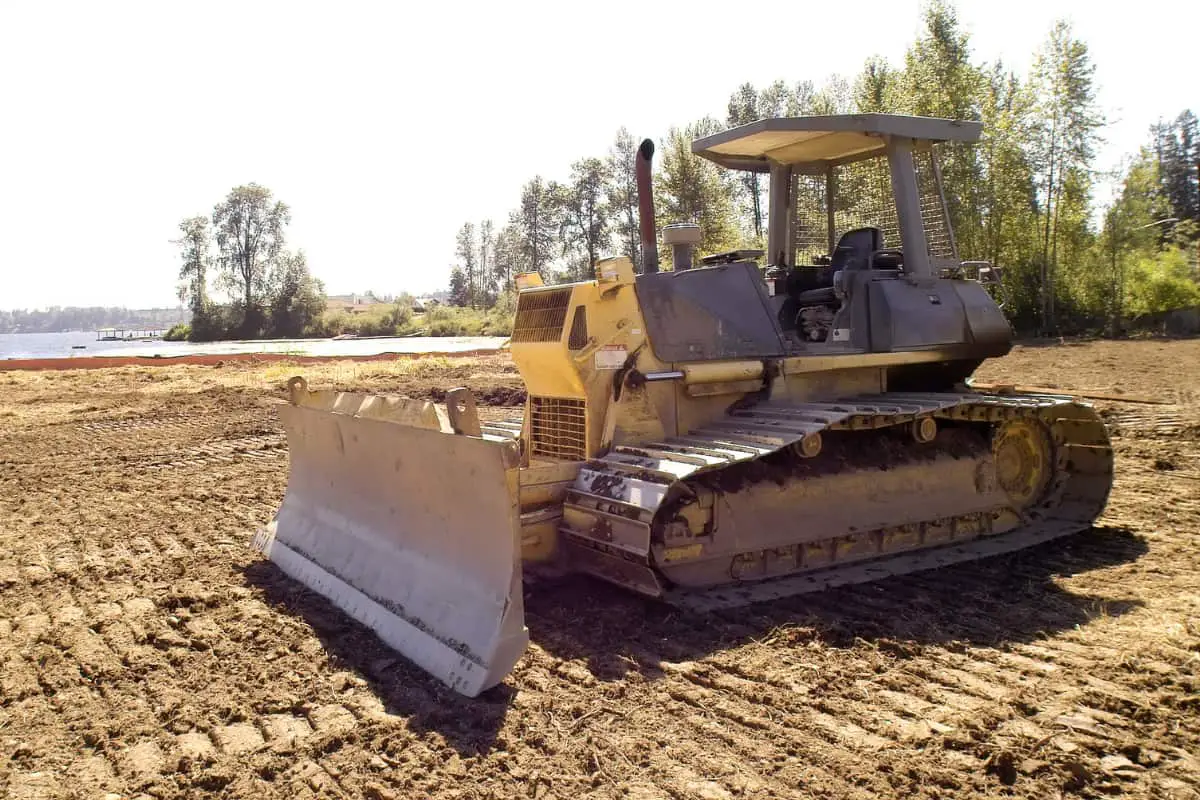Bulldozers have been modified over time to become new machines capable of performing tasks that the original versions could not. If you critically examine the tracks on a current bulldozer and compare them to earlier model track loaders, you’ll notice that the driving sprocket is placed high.
The end drive and drive sprocket are built high above the ground and have multi-terrain loaders on most compact tracks. These tracks take on a triangular shape instead of an elongated rectangular shape (aka scalene triangle). This contemporary design is known as a “high drive” design.
Have you ever wondered why bulldozers are built with triangular tracks and how they benefit their operation? Well! The short answer is bulldozers have triangular tracks to prevent them from sinking into ruts. The track allows them to stay above ground and save the engine power into push and pull power. A bulldozer without tracks loses much of its potential since most of its power is consumed when it comes out of ruts.
Now, if you’re curious about the benefits of triangular tracks in bulldozer operation, then this write-up is exclusively a treat for you. We’ll provide satisfactory answers to all your queries about this subject in this post. Continue reading to learn more.

What are Bulldozers?
Bulldozers are large, strong machines used to push, dig, excavate, and level materials such as soil and waste in road construction, mining, forestry, land clearing, infrastructure development, and other projects requiring highly mobile, strong, and reliable earth-moving equipment.
What are the key features of a bulldozer?
Blades, rippers, and tires or tracks are the key features that distinguish bulldozers.
A big, heavy blade characterizes a bulldozer’s front portion, mainly used to push material. And the ripper, absent in some models, characterizes the back – to help break up rough terrain.
Because of its design, bulldozers can be used in different terrain.
Typically, the mobility of a bulldozer is strongly influenced by its tracks and tires. Tracks are excellent for navigating difficult, uneven terrain, whilst tires are better for soft ground. If you’re working in a delicate location that you don’t want to damage, you might also want to consider tires.
Why do bulldozers have (triangular) tracks?
Conveyor systems on bulldozers are designed to take advantage of the track system and offer good tractive force. Bulldozers’ tracks provide them with great ground-holding capability and movement through extremely uneven terrain.
Triangular tracks help distribute the bulldozer’s weight over a larger area (lowering ground pressure), preventing it from sinking on sandy or muddy soil. Simply put, a high third wheel driving the track allows the drive system (engine, transmission) to be installed in a single line, eliminating the dropbox and all the extra gears that come with it.
What are the advantages of bulldozer tracks over wheels?
The main advantage of tracks over wheels is that they provide a larger surface area to distribute weight. This results in a significant reduction in ground pressure.
A normal car’s ground pressure is equal to its tire pressure, and it is concentrated in a small area; however, with a track, you can have a vehicle that moves much faster while having less pressure.
Example! An M1 Abrams tank holds a ground pressure of 15 psi, while a Volkswagen Bug has more than 30 psi. This means they’ll be able to move around on the ground without slipping and sliding as much. This, combined with the increased traction provided by the cleats, is why you’d want to use them on a heavy vehicle.
Because the track makes touch with a large ground area, tracked vehicles can readily go through uneven terrain. A car only has four feet of track to grip the ground, whereas a tracked bulldozer has dozens of feet of track.
The track also has a thick tread that burrows into muddy conditions and never flattens like a tire.
What are the Benefits of Using a Trencher on a Sloped Landscape?
Using a trencher for sloped landscapes offers numerous benefits. Firstly, it enhances the efficiency of digging trenches on uneven terrain, saving time and effort. Secondly, it ensures precise and consistent trenching depths, preventing erosion and soil erosion on slopes. Furthermore, using a trencher reduces the risk of manual labor injuries and provides a safer working environment. Overall, using a trencher on a sloped landscape streamlines the process and yields better results.
What is the Use of a Caterpillar Track in a Bulldozer?
One of the most significant advantages is that it raises the drive sprocket above the ground, where the most wear and expenditure occurs. “Due to undercarriage wear alone, a bulldozer is one of the most expensive vehicles to operate on a construction job.”
How Does Triangular Tracks Benefit Bulldozer Operation
As earlier stated, caterpillar tracks are similar to conveyor belts in that they work on the same concept. One or more steel sprockets rotated by the tank engine move a track made up of hundreds of metal links. The tank’s wheels follow the moving track in the same way that a car’s wheels follow the road.
A triangle track’s design concept is to wrap an endless belt around the front and back wheels, creating a considerably bigger bearing surface on the ground, allowing the vehicle to cross softer surfaces and get greater traction.
However, the fact that this is essentially a ‘gear and chain’ drive system with pads attached to the ‘chain’ to reduce/spread out the ground pressure is not obvious. The drive, often known as a “low-track dozer,” remained mostly unmodified until the mid-1970s.
The ‘high drive,’ also known as a “high-track” dozer, was developed by Caterpillar and is currently utilized on most (usually considerably bigger) track-type tractors/bulldozers.
Notwithstanding, the conventional drive/track arrangement is still utilized on most smaller tractors (weighing between 15 to 20,000 pounds), mainly employed for light-weight jobs such as landscaping and residential building. Grading is the primary function of the low-track machine.
The triangular track is used by the majority of today’s larger dozers for mining, stockpiling, and heavy ground construction such as road-building.
Its purpose is essentially to push, with one of the most significant benefits being to raise the drive sprocket above the ground, which is where most wear and expenditures occur.
A dozer is one of the most expensive vehicles to operate on a construction site due to undercarriage wear alone.
Conclusion
To conclude, ‘high drive’ is a relatively new-to-the-industry shift. It isn’t exclusive to Caterpillar. This model is also available from other manufacturers.
Numerous huge ‘farm-type’ tractors are now using a three-point (triangular) track drive, a shorter version of the bulldozer high-track system. Moreover, many ‘farm-tractor-look-alike’ machines are now being employed in heavy construction and high-production-field work – many with the ‘high-track’ drive.
Thanks for reading to the end. And we hope you learn much!


![Moving Your Non-Running Bulldozer [ Repairs or Junking ]](https://heavymachineryworld.com/wp-content/uploads/2021/05/how-to-move-a-non-running-bulldozer.jpg)

![Towing a Bulldozer [ Can You & Why ]](https://heavymachineryworld.com/wp-content/uploads/2021/05/can-a-bulldozer-be-towed.jpg)